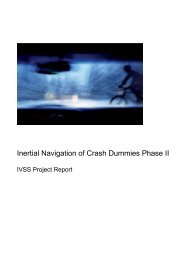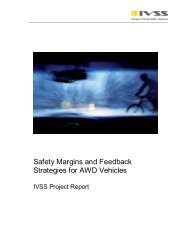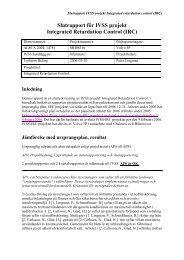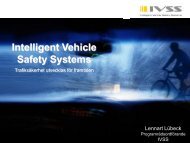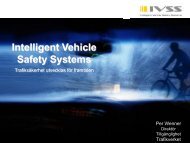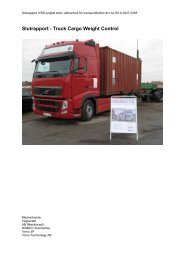7. Fulfilment of IVSS objectives - IVSS Intelligent Vehicle Safety ...
7. Fulfilment of IVSS objectives - IVSS Intelligent Vehicle Safety ...
7. Fulfilment of IVSS objectives - IVSS Intelligent Vehicle Safety ...
Create successful ePaper yourself
Turn your PDF publications into a flip-book with our unique Google optimized e-Paper software.
approximately 20 days, logging continued, and warnings for inattention and drowsiness<br />
were not only logged but also given to the driver. The drivers’ subjective opinion about<br />
the warning system and their expectations and experiences were obtained via a set <strong>of</strong><br />
questionnaires and by interviewing the drivers.<br />
Four male drivers, from two transportation companies engaged in long-haul delivery<br />
runs, participated in the Scania field tests. The experiments were run for one week per<br />
condition (without and with warnings to the driver), a total <strong>of</strong> two weeks for each<br />
participant, which yielded around 40-50 hours <strong>of</strong> total driving time per participant. As a<br />
comparison, the Saab-study generated similar amounts <strong>of</strong> driving hours per participant.<br />
The same data as in the Saab study was collected.<br />
5. Results<br />
Generally the method used in the present study appears to be suited for investigating<br />
driver distraction. A substantial number <strong>of</strong> distraction cases were logged. The automatic<br />
eye tracking worked well over a prolonged time period without intervention by the<br />
experimenter. The quality <strong>of</strong> the tracking was constant over time, and the very varying<br />
lighting conditions did not adversely affect tracking. The data acquisition system worked<br />
as planned in principle, even though stability issues have to be solved in future studies,<br />
and a better power management is required for further and more large-scale studies.<br />
Passenger car:<br />
Generally, the experiences with the participants were positive, and the procedure used<br />
seemed to have worked for all involved. The large variation between participants for<br />
many <strong>of</strong> the analysed performance indicators shows clearly that the number <strong>of</strong><br />
participants was too low to draw any definite conclusions about the effect <strong>of</strong> the<br />
distraction warning system. The data from the present study suggest that the warnings do<br />
not have an immediate effect such that the driver looks up faster after having received a<br />
warning than without warning. It does not appear, either, that drivers try to avoid the<br />
warnings, because for most <strong>of</strong> the drivers the warning frequency did not decrease<br />
measurably. There is no increased concentration <strong>of</strong> glances in the field relevant for<br />
driving, or an increase in PRC values (Percent Road Center) in the treatment condition.<br />
Neither does the distribution <strong>of</strong> gazes change from the baseline to the treatment phase.<br />
The only possible change could be found for the duration <strong>of</strong> individual glances, where it<br />
seems like the percentage <strong>of</strong> very long glances decreased in the treatment phase.<br />
Furthermore, the number <strong>of</strong> times the attention buffer returned to zero before filling up<br />
completely after a warning appears to have decreased.<br />
Thus, the results do not show very large effects, but those that appear tend to go into<br />
the “right” direction, meaning that a distraction warning could have positive effects<br />
on driving safety and does not seem to have negative effects. The few effects that<br />
appeared did not change much over time. This might indicate that there is no noteworthy<br />
11




